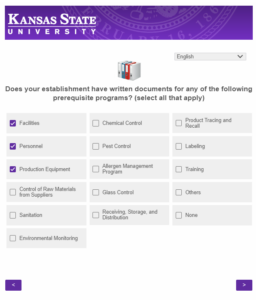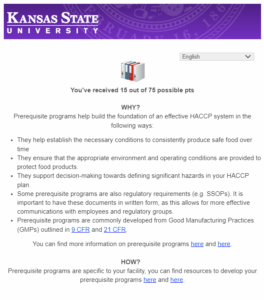Final report for GNC22-353
Project Information
The increased interest in the consumption of local products, including meat and meat products, has allowed small and very small (SVS) meat processors to gain more visibility in the market. SVS facilities represent >90% of the federally-inspected establishments in the United States. In Kansas, the animal slaughter and meat processing sectors, have an output of $10.9 billion. While some of the SVS facilities in Kansas have been operating for several years, others just recently were established or are expanding their operations. This represents an opportunity and need for standardized education and training approaches for SVS personnel. There are several requirements that meat processing facilities have to comply with especially in regard to food safety programs, this includes a Hazard Analysis and Critical Control Points (HACCP) plan. Successful food safety programs require commitment and engagement from all personnel of a processing facility and an understanding of their role in food safety. There is a large proportion of the workforce in SVS facilities that are of Latino origin, and thus, providing education and training in their primary language reduces language barriers and increases successful knowledge-transfer. The objective of this project is to provide SVS meat processors with spaces for learning and developing effective and compliant food safety programs, including HACCP plan, microbial testing programs, and other food safety requirements. We will hold food safety lectures in English and Spanish, workshops for designing/adapting HACCP plans, and for adequate practices in microbial testing programs. Additionally, we will carry out initial on-site readiness assessment for SVS plants, as well as final audit-like evaluation for the correct implementation of food safety practices after the lecture/workshops. Written assessments will be collected before and after each lecture and workshop. All the data obtained and results generated will be shared through extension briefs, peer-reviewed manuscripts and poster presentations at a conference. We anticipate that increasing the knowledge and skills of SVS facilities in terms of food safety and regulatory requirements will increase their engagement and commitment to following adequate food safety practices. Moreover, we expect that providing educational programs in Spanish to the SVS workforce will ease the transfer of knowledge to Spanish speakers and increase their sense of belonging and commitment to food safety. Through the improvement of food safety programs, SVS will be supporting the reduction of food insecurity, the incidence of foodborne outbreaks, increasing their market potential and visibility for customers.
Learning outcomes
- Meat processors will learn about the differences among regulatory requirements (state and federal), HACCP requirements and third-party audits schemes.
- Meat processors will learn how to develop/adapt, implement and manage their own HACCP plans.
- Meat processors will understand how to reassess and modify their food safety programs when necessary due to modifications in their products or processes, or due to requirements.
- Meat processors will learn how to effectively design and implement verification and validation programs.
- Meat processors will be guided through microbial testing programs, including appropriate sample collection practices, transport, and processing of samples.
Action outcomes
- Initial on-site assessments of the SVS processing plants’ readiness for compliance with regulatory requirements and implementation of the HACCP plan.
- A food safety lecture series about food safety requirements.
- A hands-on workshop to a) Carry out preliminary tasks for their HACCP plan, and b) Develop/adapt individual HACCP programs specific to their processing facility.
- A laboratory workshop to conduct appropriate and effective microbial sample collection and testing procedures.
- Follow-up on-site visit to the SVS meat processors to evaluate the correct implementation of the food safety programs and HACCP plans developed during the workshops.
Condition outcomes
- Increased compliance with state and federal requirements and potential status for third-party certifications.
- Increased engagement and sense of belonging by receiving training and education in their primary language (for English/Spanish-speakers).
- Broadening SVS processors’ opportunities to access bigger markets (e.g. interstate) that require specific programs and certifications.
- Strengthened relationship between Kansas State University and SVS processors.
Cooperators
- (Educator)
- (Researcher)
- (Educator)
Research
A survey was distributed to small meat processors in Kansas to better understand their food safety needs. A total of 28 processors participated in the survey. The majority of respondents indicated a need for support in several areas, including good manufacturing practices (GMPs), understanding and applying the new Appendix A and B guidelines, HACCP plan development, and small business management.
To address the needs of processors regarding GMPs and HACCP, a tool was developed to assess the effectiveness of their current food safety programs. The tool is divided into four sections: I) Documents and Procedures (12 questions), II) Sanitation (9 questions), III) HACCP (12 questions) or GMP (17 questions), depending on the processor's inspection status, and IV) Records and Recordkeeping (9 questions). Each section includes questions that focus on regulatory requirements (State or Federal) and encourages processors to provide realistic responses.
Each question is scored based on its relevance to food safety, with immediate feedback provided after each answer to explain the reasoning and suggest improvements. The feedback includes links to online resources for further reading, along with templates and models to help processors develop their own food safety programs. The self-assessment tool was created using Qualtrics XM and is designed to allow processors to complete the assessment within a month, providing ample time for a thorough evaluation. At the end of the survey, results can be downloaded as a PDF, enabling processors to track their progress and improvements. They can conduct the assessment as often as needed to monitor their food safety systems and identify positive or negative trends.
To address the challenges identified in Appendix A and B requirements, an in-person training program was developed to support small meat processors in Kansas. During the development process, an opportunity arose to expand the program to other states, including Nebraska, Oklahoma, and South Dakota. As a result, four in-person training sessions were held during the annual state small meat processing association meetings in each state. The training offered an overview of the changes to the Appendix A and B guidance from USDA-FSIS and provided participants with practical methods for applying these changes to their programs and facilities to ensure compliance. To assess the impact of the training, a pre- and post-training survey was conducted at each session, measuring changes in participants' perceptions of their capabilities, opportunities, and motivations to comply with the new guidance. A total of 47 responses were recorded for the pre- and post-survey responses. This survey is based upon the COM-B model for behavior (B) change due to perceived levels of capabilities (C), opportunities (O), and motivations (M). This survey included a total of four questions designed to measure perceived motivations, nine questions designed to measure perceived opportunities, and 17 questions designed to measure motivations. This survey tool was provided per-training and post-training.
The SAFE tool is currently available in both English and Spanish for small processors to use at their convenience through the following link: https://kstate.qualtrics.com/jfe/form/SV_aWpOQHIeOfEbGbI. To date, a total of 28 responses have been recorded. Additionally, the KSU Meat Science Team is in the process of renovating the extension website, and the SAFE tool will be featured on the updated site, which is expected to increase its visibility and usage.
Regarding the pre- and post-assessment results for the in-person training on Appendix A & B compliance, no significant differences were observed in perceived capabilities, motivations, or opportunities across the four states. However, processors in Nebraska reported the highest perceived capabilities overall, while those in South Dakota reported the lowest. All states had similar perceptions of their opportunities and motivations. On average, regardless of the state, respondents indicated an increase in perceived capabilities and opportunities in the post-training surveys compared to the pre-training surveys. In contrast, the training intervention did not appear to impact respondents' perceived motivations.
Educational & Outreach Activities
Participation Summary:
The self-assessment tool is designed to help small meat processors evaluate the effectiveness of their food safety programs. While it is currently available, it will soon be accessible online through the K-State Outreach and Extension website, making it easily accessible for processors across the region. The tool will also be widely distributed through multiple channels, including email and social media, via the Kansas Meat Processors Association. This strategy ensures that processors are aware of the tool and can easily integrate it into their operations.
The tool’s distribution through these platforms will increase its visibility and accessibility, allowing a broader audience of small meat processors to use it for assessing and improving their food safety practices. The primary purpose of the tool is educational, aimed at supporting continuous improvement by enabling processors to assess their own food safety programs and identify strategies for enhancement.
A key feature of the tool is its ability to provide resources throughout the assessment process. As processors work through the self-assessment, the tool directs them to regulatory guidance and scientific resources, helping them deepen their understanding of regulatory expectations and requirements. This integrated support helps processors build their knowledge and implement best practices for food safety within their operations.
In-person training programs were conducted at the annual small meat processor association meetings for Kansas, Nebraska, Oklahoma, and South Dakota. These programs were developed to address a specific challenge identified in a survey of Kansas small meat processors. Initially designed for Kansas, the training was expanded to include three additional states, offering valuable resources and support to processors across the region.
The training directly addressed key changes introduced in the USDA-FSIS updates to the regulatory guidance documents, Appendix A (guidance for lethality) and Appendix B (guidance for stabilization). The program provided an overview of the recent updates and then guided participants through real-world scenarios, illustrating how these changes would impact small meat processors. Additionally, strategies for applying the updated guidelines were discussed to help ensure compliance.
The training concluded with a question-and-answer session, providing participants an opportunity to seek further guidance on specific challenges they were facing. This interactive portion allowed processors to share their own experiences in adopting the new guidance, fostering a collaborative learning environment. Three handouts were also provided to training participants, including a three page leaflet that presented key changes to the guidance and the updated Appendix A lethality combinations (laminated) and the updated Appendix B stabilization guidance (laminated).
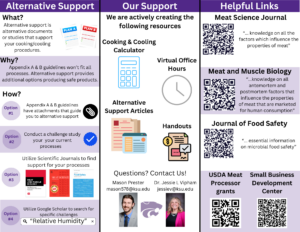
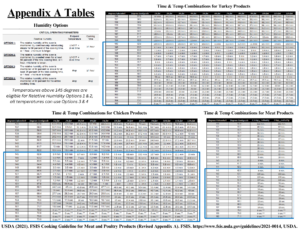
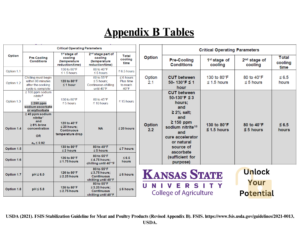

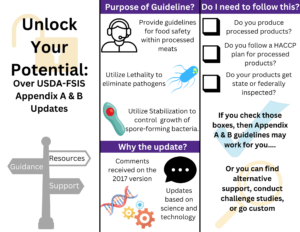
Project Outcomes
The "Self-Assessment for Food Safety Excellence (SAFE)" tool we have developed is designed to help small meat processors evaluate and improve their food safety programs. This online tool allows processors to assess their current practices, identify gaps, and receive guidance on how to develop the necessary documentation and implement food safety practices that comply with state or federal regulations. The tool is structured in four sections: I) Documents and procedures, II) Sanitation, III) HACCP or GMP (depending on inspection status), and IV) Records and recordkeeping. Each section includes questions that help processors understand the current state of their practices and determine whether they meet regulatory requirements. After each question, the tool provides feedback on why the practice is important and how to comply with the relevant regulations.
This self-assessment tool has the potential to contribute significantly to agricultural sustainability in several ways—economic, environmental, and social. For example, one of the major goals of the SAFE tool is to provide a learning tool for continuous improvement for small processors. We anticipate that improvements to food safety programs will provide opportunities for small meat processors to enhance the quality and reliability of their products, which may make them eligible for access to larger, more diverse markets, both locally and regionally. This increased market access can lead to higher sales and profits. Additionally, by ensuring compliance with food safety regulations, processors can avoid costly fines and recalls, which can be financially devastating, especially for small businesses. The tool also provides processors with resources to help optimize their operations, reduce waste, and improve efficiency, contributing to better financial performance and long-term business sustainability. Additionally, the SAFE tool encourages processors to evaluate their current practices in areas such as sanitation and waste management. By identifying areas for improvement, processors can adopt more environmentally sustainable practices, such as reducing water and energy use, minimizing waste, and improving the overall environmental footprint of their operations. This is particularly important for small processors who may not have the resources to implement comprehensive sustainability programs without such guidance. The tool supports a culture of continuous improvement, which may foster environmental responsibility within the food processing sector.
Overall, the SAFE tool empowers small meat processors to improve their operations, increase their market reach, enhance food safety, and reduce waste—all of which contribute to a more sustainable agricultural system. By providing these processors with the tools and resources to grow and improve, we are supporting the long-term sustainability of small businesses, local economies, and the agricultural sector as a whole.
During the course of this project, our knowledge, attitudes, skills, and awareness about sustainable agriculture have evolved significantly, largely as a result of engaging with the training program and the development of the SAFE tool. Initially, our understanding of sustainable agriculture was focused primarily on large-scale practices and their impact on the environment. However, through our engagement with small processors, we gained a deeper understanding of how sustainable agriculture principles can be applied on a smaller scale. We learned how improving food safety programs can contribute to long-term sustainability not only by ensuring regulatory compliance but also by helping processors minimize waste, improve resource efficiency, and enhance their product quality. Additionally, we expanded our knowledge of food safety regulations and the specific challenges small processors face in meeting those requirements, which highlighted the need for accessible, practical tools like SAFE to support continuous improvement.
Our attitude toward sustainable agriculture has become more inclusive and holistic. We initially viewed sustainability as a primarily environmental concern, but through the project, we came to realize that sustainability also encompasses economic and social dimensions. By providing small processors with the tools and resources to improve their food safety programs, we now see sustainability as a comprehensive approach that includes fostering local economies, supporting small businesses, reducing foodborne illnesses, and addressing community health and food insecurity. We also recognized that sustainability is not just about environmental practices but also about empowering small producers to thrive in a competitive marketplace.
Through the development of the SAFE tool, we have gained experience in creating practical, user-friendly tools that address real-world challenges in the food industry. Additionally, we developed skills in understanding the regulatory landscape and applying it to day-to-day operations. The project also developed our skills in designing educational materials, including non-experts and Spanish-speaking processors. Additionally, the project increased our awareness of the specific barriers small meat processors face in adopting practices, including the challenges of meeting regulatory requirements with limited resources and the critical role that education and training play in overcoming those obstacles. We also became more aware of how small-scale operations contribute to the larger agricultural system and the importance of supporting these businesses to ensure food safety, public health, and economic sustainability. Additionally, the development of a bilingual tool made us more conscious of the language barriers, which can limit access to educational resources.
We are very interested in conducting further outreach initiatives to further support small meat processors. One of these areas of interest is to finalize efforts to provide user-friendly support tools for financial decisions making. Moreover, we have really enjoyed this opportunity to work on this project.
